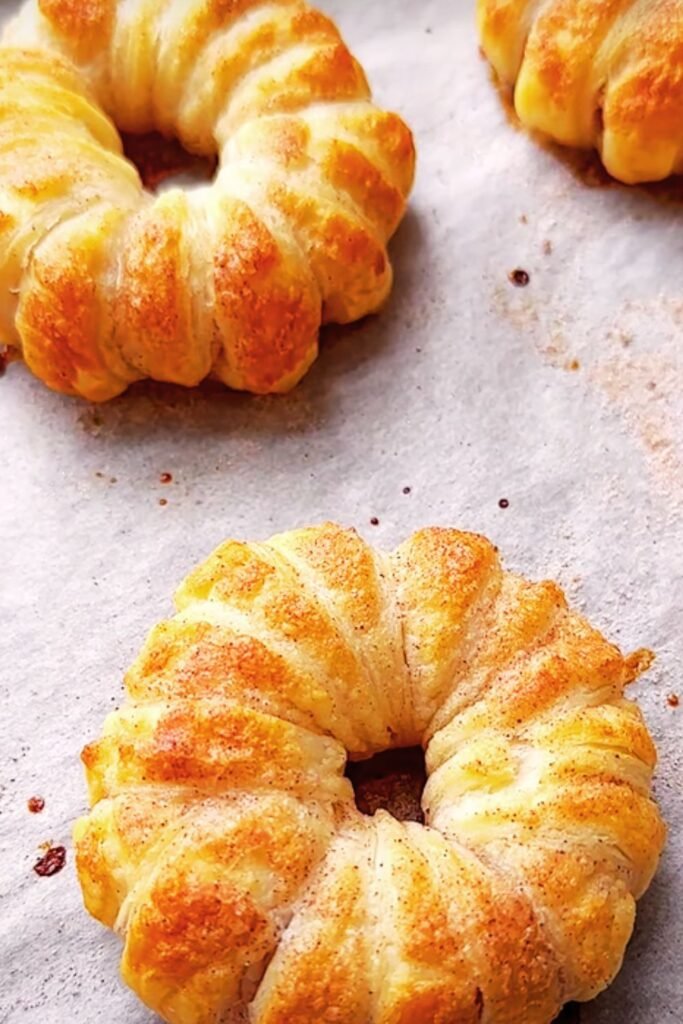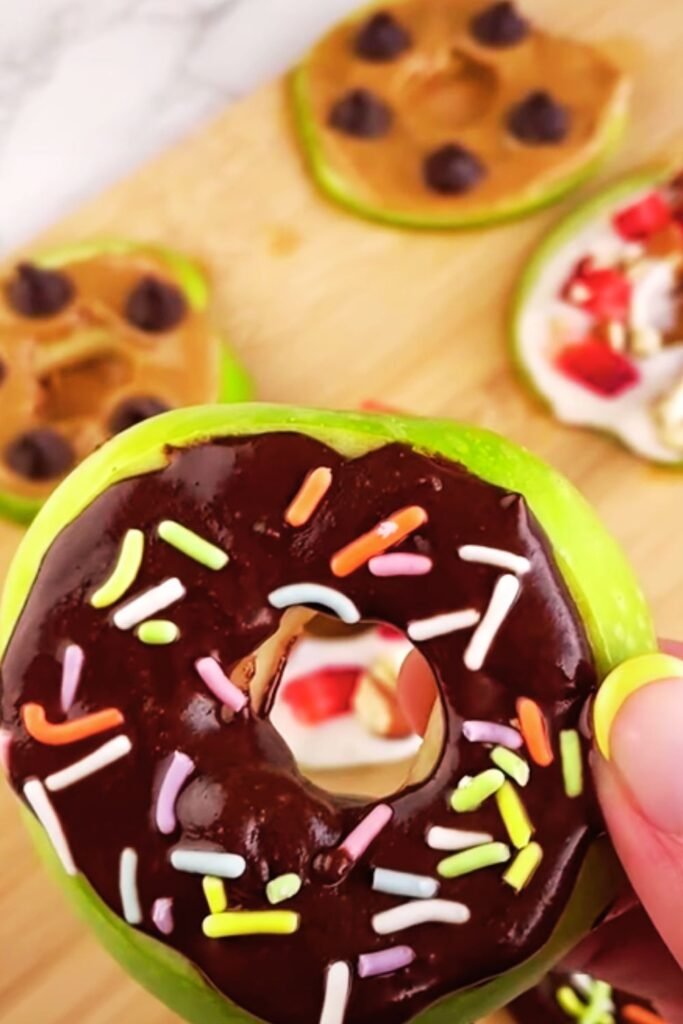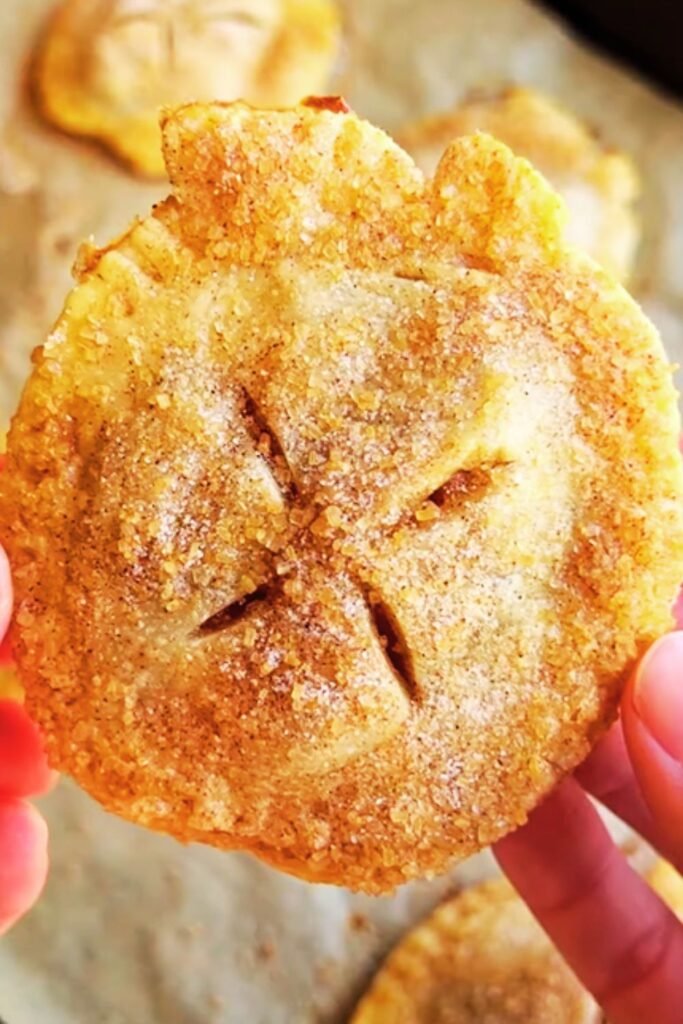There’s something magical about the aroma of fresh doughnuts mingling with the warm spices of apple pie. I’ve spent countless mornings perfecting this recipe, and I can honestly say these apple pie doughnuts represent the best of both worlds. They capture the comforting essence of homemade apple pie wrapped in the irresistible appeal of a freshly fried doughnut.
When autumn rolls around, I find myself craving those familiar flavors that define the season. These doughnuts deliver exactly that – tender, cake-like texture infused with real apple pieces, warm cinnamon, and a hint of nutmeg. What makes them truly special is how they manage to taste like apple pie without being overly sweet or heavy.
I’ve discovered that the secret lies in using fresh apples that are diced small enough to distribute evenly throughout the dough, while still maintaining their texture and flavor. The result is a doughnut that’s both familiar and surprising, perfect for breakfast, dessert, or that afternoon treat we all secretly crave.
Understanding Apple Pie Doughnuts
Apple Pie Doughnuts : Yeasted or cake-style doughnuts that incorporate diced apples, warm spices, and often feature a cinnamon-sugar coating or glaze reminiscent of apple pie filling.
Cake Doughnuts : Dense, tender doughnuts made with baking powder or baking soda as leavening agents, creating a cake-like texture that holds mix-ins well.
Yeasted Doughnuts : Light, airy doughnuts made with active yeast, requiring rising time but resulting in a fluffy, bread-like texture.
Apple Varieties for Baking : Firm apples that hold their shape when cooked, such as Granny Smith, Honeycrisp, or Braeburn, which provide the ideal balance of sweetness and tartness.
The beauty of apple pie doughnuts lies in their versatility. I’ve made both cake-style and yeasted versions, and each brings something unique to the table. The cake version offers immediate gratification – you can mix, fry, and enjoy within an hour. The yeasted version requires patience but rewards you with an incredibly light texture that seems to melt in your mouth.
Essential Ingredients and Their Roles
Creating the perfect apple pie doughnut starts with understanding how each ingredient contributes to the final result. I’ve learned through trial and error that quality ingredients make an enormous difference in both flavor and texture.
| Ingredient | Purpose | Best Options | Substitution Notes |
|---|---|---|---|
| All-Purpose Flour | Structure and texture | Unbleached preferred | Can use bread flour for chewier texture |
| Fresh Apples | Flavor and moisture | Granny Smith, Honeycrisp | Avoid Red Delicious (too soft) |
| Brown Sugar | Sweetness and moisture | Light or dark brown | Dark adds deeper molasses flavor |
| Eggs | Binding and richness | Room temperature | Large eggs standard |
| Butter | Flavor and tenderness | Unsalted preferred | Can substitute with vegetable oil |
| Cinnamon | Warm spice flavor | Ceylon or Cassia | Ceylon is milder and sweeter |
| Nutmeg | Aromatic depth | Freshly grated preferred | Pre-ground acceptable |
| Vanilla Extract | Flavor enhancement | Pure vanilla only | Avoid imitation vanilla |
| Baking Powder | Leavening agent | Double-acting preferred | Check expiration date |
| Salt | Flavor balance | Fine sea salt | Enhances all other flavors |

The apple selection deserves special attention. I’ve experimented with numerous varieties, and I consistently return to Granny Smith for their reliable tartness and firm texture. They maintain their shape during mixing and frying, providing delightful bursts of apple flavor in every bite. Honeycrisp apples work beautifully too, offering natural sweetness that reduces the need for additional sugar.
When preparing the apples, I dice them into quarter-inch pieces. This size ensures they distribute evenly throughout the dough while remaining substantial enough to provide texture. Smaller pieces tend to disappear into the batter, while larger chunks can create uneven cooking and structural weak points in the doughnut.
Step-by-Step Preparation Method
My approach to making apple pie doughnuts has evolved over years of practice. I’ve streamlined the process to minimize mess while maximizing flavor development.
Preparing the Apples
The apple preparation is crucial for success. I start by peeling and coring my selected apples, then dice them uniformly. To prevent browning and add a subtle flavor enhancement, I toss the diced apples with a tablespoon of lemon juice and a teaspoon of sugar. This mixture sits for about fifteen minutes, allowing the apples to release some moisture while the sugar begins to draw out their natural flavors.
Creating the Dough
For the dough base, I combine all dry ingredients in a large mixing bowl, whisking thoroughly to ensure even distribution. In a separate bowl, I mix the wet ingredients – eggs, melted butter, milk, and vanilla extract. The key is having all ingredients at room temperature, which promotes better mixing and a more uniform texture.
When combining wet and dry ingredients, I use a gentle folding motion rather than aggressive mixing. Overmixing develops the gluten too much, resulting in tough, chewy doughnuts instead of the tender texture we’re after. I mix just until the ingredients come together, then fold in the prepared apples.
Shaping and Cutting
The dough should be soft but manageable. I turn it onto a lightly floured surface and pat it to about three-quarter inch thickness. Using a well-floured doughnut cutter (or a large round cutter plus a smaller one for the center), I cut the doughnuts with confident, straight-down motions. Twisting the cutter can seal the edges and prevent proper rising.

I’ve learned to save the doughnut holes – they make perfect test pieces for oil temperature and delicious little treats on their own.
Frying Techniques and Temperature Control
Oil temperature control separates good doughnuts from great ones. I maintain my oil at 350°F (175°C) throughout the frying process. Too cool, and the doughnuts absorb excess oil, becoming greasy. Too hot, and they brown too quickly while remaining raw inside.
Oil Selection and Depth
I prefer using vegetable oil or canola oil for their neutral flavors and high smoke points. The oil depth should be at least three inches to allow the doughnuts to float and cook evenly. I use a heavy-bottomed pot or Dutch oven, which maintains temperature better than thin-walled pans.
The Frying Process
I fry only two to three doughnuts at once to avoid overcrowding, which drops the oil temperature. Each doughnut gets approximately ninety seconds on the first side – I look for a golden-brown color rather than timing strictly. After flipping, they need about sixty seconds on the second side.
The moment of truth comes when removing them from the oil. I use a slotted spoon or spider strainer, allowing excess oil to drain before transferring to a wire cooling rack set over paper towels.
Coating and Finishing Options
The coating transforms these doughnuts from good to extraordinary. I’ve developed several finishing options, each offering a different experience.
| Coating Type | Ingredients | Application Method | Best For |
|---|---|---|---|
| Cinnamon Sugar | 1 cup sugar, 2 tsp cinnamon | Roll warm doughnuts | Classic apple pie flavor |
| Apple Cider Glaze | Powdered sugar, apple cider, vanilla | Dip cooled doughnuts | Enhanced apple flavor |
| Brown Butter Glaze | Butter, powdered sugar, milk | Drizzle over doughnuts | Rich, nutty complement |
| Caramel Drizzle | Caramel sauce, sea salt | Drizzle pattern | Indulgent finish |
| Plain Sugar | Granulated sugar | Roll immediately after frying | Simple, traditional |
My personal favorite is the cinnamon sugar coating applied while the doughnuts are still warm. The heat helps the coating adhere perfectly while the cinnamon complements the apple flavors beautifully.
For the apple cider glaze, I reduce fresh apple cider by half to concentrate the flavor before mixing with powdered sugar and a splash of vanilla. This creates a glaze that tastes intensely of apples without being overly sweet.
Nutritional Information and Dietary Considerations
Understanding the nutritional content helps make informed decisions about portion sizes and frequency of enjoyment.
| Nutrient | Per Doughnut (Average) | Daily Value % |
|---|---|---|
| Calories | 285 | 14% |
| Total Fat | 12g | 15% |
| Saturated Fat | 3g | 15% |
| Cholesterol | 35mg | 12% |
| Sodium | 180mg | 8% |
| Total Carbohydrates | 42g | 15% |
| Dietary Fiber | 2g | 7% |
| Sugars | 18g | – |
| Protein | 4g | 8% |
| Vitamin C | 3mg | 3% |
| Calcium | 45mg | 3% |
The apples contribute beneficial fiber and vitamin C, while the enriched flour provides B vitamins and iron. These doughnuts are treats meant for occasional enjoyment rather than everyday consumption.
Dietary Modifications
I’ve successfully adapted this recipe for various dietary needs. For those avoiding dairy, I substitute the milk with non-dairy alternatives like oat milk or almond milk. The butter can be replaced with vegan butter or neutral oil, though this changes the flavor profile slightly.
Gluten-free versions require a different approach entirely. I use a combination of rice flour, tapioca starch, and xanthan gum, though the texture differs from the traditional version.
Storage and Reheating Methods
Fresh doughnuts taste best within hours of frying, but proper storage extends their enjoyment window significantly.

Short-Term Storage
For same-day consumption, I store the doughnuts at room temperature in a loosely covered container. Airtight storage can make them soggy, while leaving them completely uncovered causes them to dry out quickly.
Longer-Term Storage
Doughnuts freeze remarkably well when properly wrapped. I place them in a single layer on a baking sheet and freeze until solid, then transfer to freezer bags with as much air removed as possible. They maintain quality for up to three months frozen.
Reheating Techniques
To restore freshness to day-old doughnuts, I warm them in a 300°F oven for five to eight minutes. This technique revives their texture without drying them out. Microwaving works in a pinch but can create tough spots if overdone.
Troubleshooting Common Issues
Through countless batches, I’ve encountered and solved most problems that arise with apple pie doughnuts.
Dense, Heavy Texture : Usually caused by overmixing the dough or using too much flour. Mix ingredients just until combined, and measure flour by weight when possible.
Greasy Doughnuts : Indicates oil temperature too low or inadequate draining. Maintain 350°F oil temperature and drain thoroughly on wire racks.
Raw Centers : Oil too hot, causing rapid browning while centers remain uncooked. Reduce temperature and allow doughnuts to cook more slowly.
Apples Sinking : Apples too large or dough too thin. Dice apples smaller and ensure dough consistency is adequate to support the fruit pieces.
Coating Won’t Stick : Doughnuts too cool for sugar coating or too warm for glaze. Apply sugar coating while doughnuts are still warm, glazes when completely cooled.
Serving Suggestions and Pairings
These doughnuts shine in various serving contexts. For breakfast, I serve them alongside freshly brewed coffee or chai tea. The warm spices complement both beverages beautifully.
As a dessert, they pair wonderfully with vanilla ice cream or fresh whipped cream. The temperature contrast creates an delightful sensory experience.
For special occasions, I arrange them on tiered serving stands with small bowls of additional toppings – extra cinnamon sugar, caramel sauce, or apple butter for those who want to customize their experience.
Hot apple cider makes an obvious but perfect beverage pairing, creating a cohesive apple-themed experience. For coffee lovers, I recommend medium roast coffees that won’t overpower the delicate apple and spice flavors.
Frequently Asked Questions
Q: Can I make the dough ahead of time? I don’t recommend making the full dough in advance because the apples release moisture over time, affecting the texture. However, you can prepare all ingredients separately and combine them just before frying.
Q: What’s the best way to achieve uniform doughnut shapes? Using a proper doughnut cutter makes the biggest difference. If you don’t have one, use a large round cutter (about 3 inches) and a smaller one (about 1 inch) for the centers. Keep both cutters well-floured and press straight down without twisting.
Q: How do I know when the oil is the right temperature without a thermometer? Drop a small piece of dough into the oil. If it sizzles immediately and rises to the surface within a few seconds, the temperature is close to correct. If it browns very quickly, the oil is too hot. If it doesn’t sizzle much, the oil needs more heating.
Q: Can I bake these instead of frying them? While you can bake them at 375°F for about 12-15 minutes, they won’t have the same texture or flavor as traditional fried doughnuts. Baked versions are more like muffins in doughnut shapes.
Q: Why do my doughnuts turn out tough? Tough doughnuts usually result from overmixing the dough, which develops too much gluten. Mix just until ingredients are combined, and handle the dough gently when shaping.
Q: How can I make mini doughnut versions? Use a smaller cutter set or pipe the dough into mini doughnut pans for baking. Reduce cooking time accordingly – mini versions fry in about 45-60 seconds per side.
Q: What should I do if my doughnuts are absorbing too much oil? This typically happens when the oil temperature is too low. Increase the heat and test with a thermometer or small piece of dough. Also ensure you’re draining them properly on wire racks.
Q: Can I use apple sauce instead of fresh apples? Fresh apples provide texture and distinct flavor that applesauce can’t replicate. If you must substitute, reduce the liquid in the recipe slightly and add extra cinnamon to boost the apple flavor.
These apple pie doughnuts represent the perfect marriage of two beloved treats. The process requires attention to detail, but the results justify every step. Whether you’re making them for a special breakfast, afternoon treat, or dessert, they deliver comfort and satisfaction in every bite.
The key to success lies in using quality ingredients, maintaining proper oil temperature, and not overthinking the process. Each batch teaches you something new, and soon you’ll develop the intuition that comes with experience. There’s genuine satisfaction in pulling a batch of golden, fragrant doughnuts from the oil, knowing you’ve created something that brings joy to everyone who tastes them.
Remember that cooking is as much about the experience as the final product. Enjoy the process of creating these treats, from the moment you dice the first apple to the satisfied expressions of those lucky enough to share them with you.